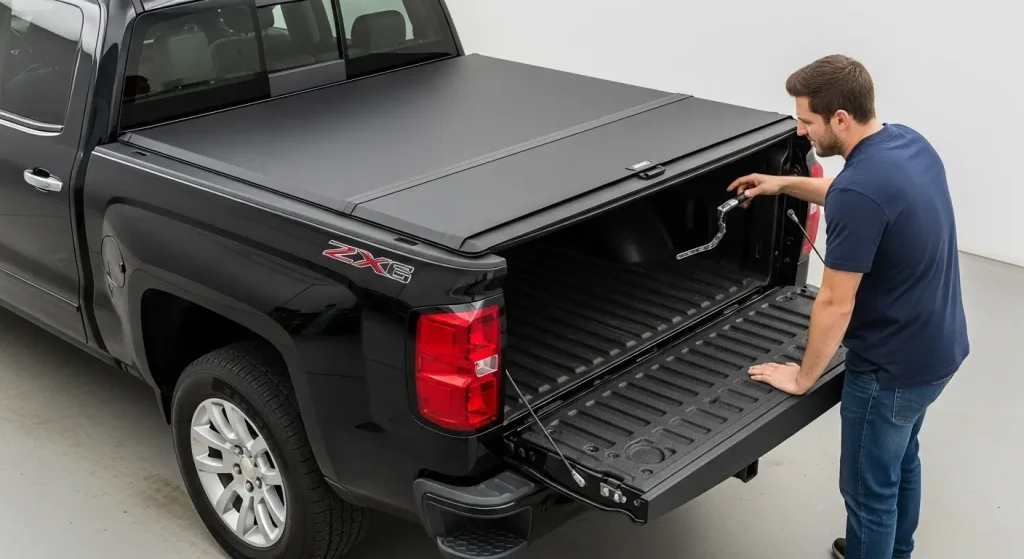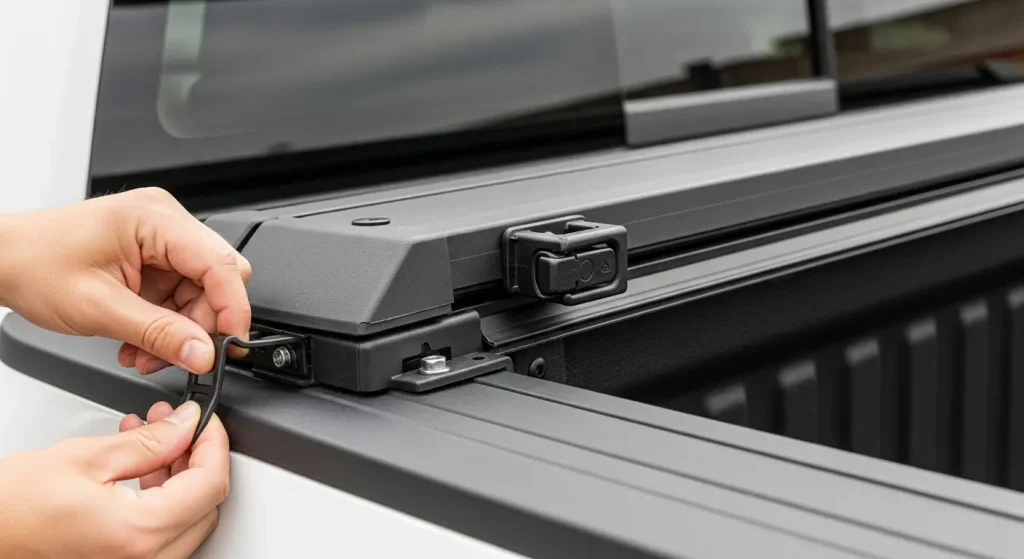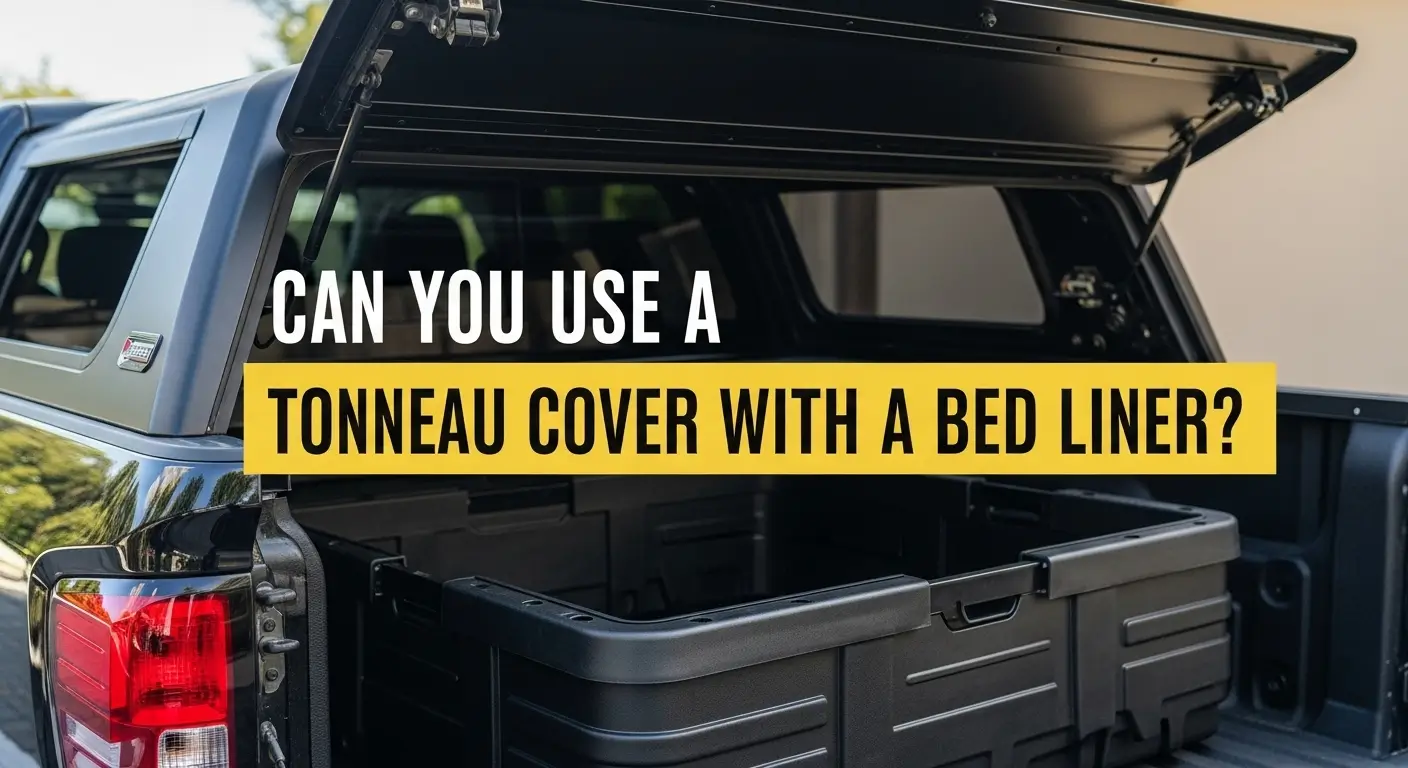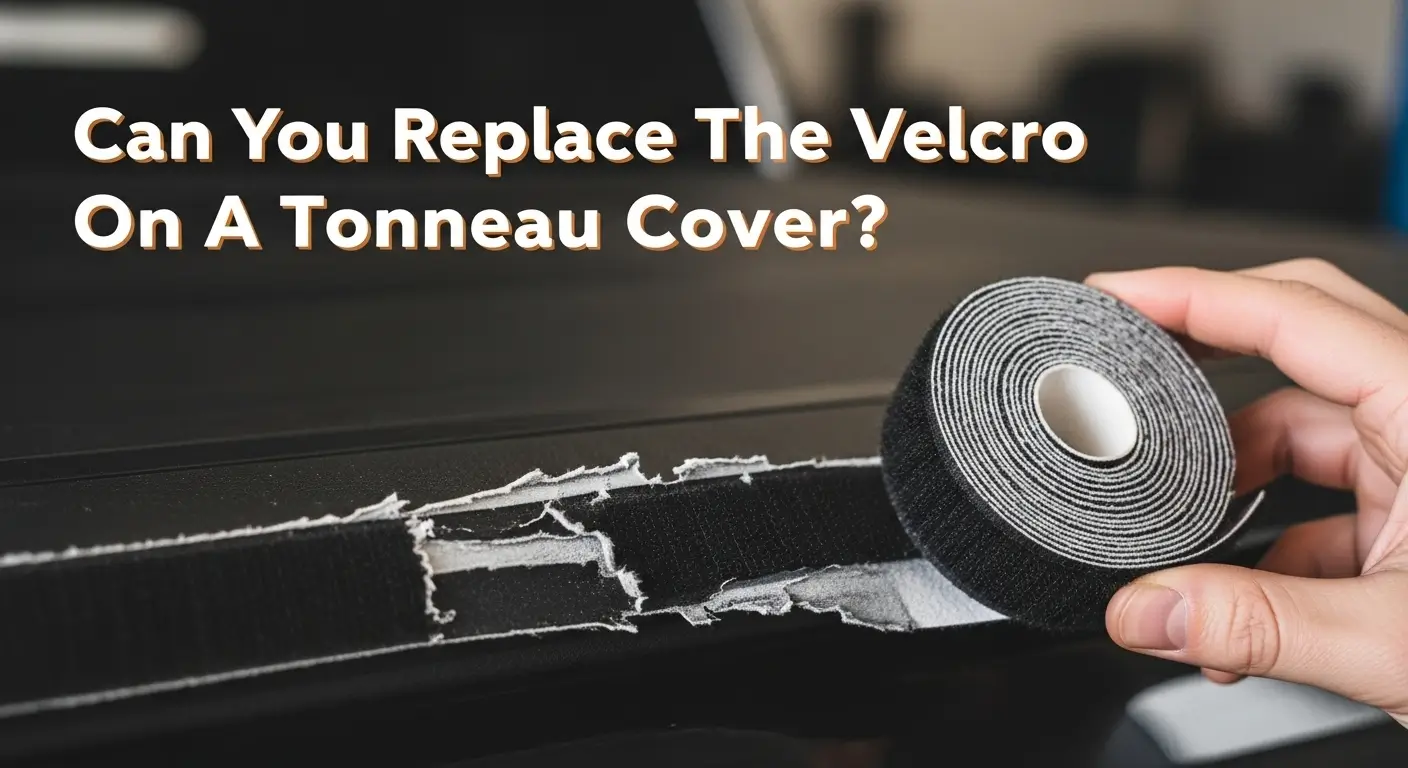A stuck tailgate can quickly turn a routine truck-bed access into a major headache-especially if you have a tonneau cover locked over the bed.
Tonneau covers are hugely popular (about 30% of U.S. truck-accessory sales in 2024) because they keep cargo dry and secure.
But that also means most covers lock to the tailgate.
In fact, many retractable and folding bed covers use an integrated tailgate lock, so if your tailgate won’t open, the cover won’t unlock either.
The only way to solve the problem is to carefully free the tailgate latch or remove/loosen the cover itself.
This step-by-step guide will walk you through all the troubleshooting techniques and preventative tips to get your tailgate and cover back open safely.
Also check- Fixing stuck truck bed cover lock
Table of Contents
Why Your Tailgate Might Be Stuck

Before jumping into fixes, it helps to know why tailgates get jammed. Common culprits include:
- Rust or corrosion in the latch: Years of road salt or moisture can gunk up the latch mechanism and prevent it from releasing smoothly.
- Frozen or dirty latch: Debris or ice can stop the latch from moving.
- Damaged latch or linkage: The internal rods and cables that connect the handle to the latches can wear out or break.
- Misalignment or binding: If the tailgate hinge or striker is out of alignment, the latch may no longer engage properly.
- Electronic actuator failure: On power-locking tailgates, the actuator motors can fail, leaving the gate electrically locked.
In many pickup bed setups, this is compounded by the tonneau cover’s lock. As one truck accessory guide explains: manufacturers often use “key-operated locks that are physically integrated into the bed’s tailgate”, meaning “you can’t open your cover while it’s shut and locked”.
In other words, if the tailgate is jammed or locked, the cover’s lock cannot disengage. The good news is that most tailgate sticking issues are fixable with tools and some know-how.
Tools & Preparation
Gather the following before you begin:
- Tools: A screwdriver (flat-head and Phillips), wrenches or a socket set, a flashlight, and lubricant (penetrating oil or silicone spray).
- Safety: Park on level ground, turn off the ignition, and wear gloves and eye protection. Place the truck in Park (automatic) or in gear (manual) with the parking brake on.
- Check for keys: Make sure you have the tonneau cover key (if separate) and the truck key. Some covers use the tailgate key.
Having tools and safety gear at hand means you’re ready to carefully diagnose and fix the issue. Remember: do not force any latches or break parts without a plan. Gentle troubleshooting is key to preventing costly damage.
Step-by-Step Fixes to Open the Cover
Follow these steps in order. Each step builds on the last, so stop when your tailgate finally opens.
Step 1: Inspect the Latch and Obstructions
Look closely at the tailgate latch from the outside. Use a flashlight to spot dirt, rust, ice or debris. If you see any, try to remove it with a wire brush or cloth.
Sometimes pushing on the tailgate (to relieve tension) while pulling the handle can free a stuck latch.
Tip: Pushing the tailgate slightly inward often releases pressure on the latches and makes them easier to open. Check also inside the bed (if you can see past the cover) for jammed cargo or obstructions.
Step 2: Lubricate the Latch Mechanism
Generously spray a penetrating lubricant or silicone spray on the latch, hinges, and moving parts. Focus on the latch area where the handle release moves and any pivot points.
According to auto experts, lubrication can often restore smooth movement.
Work the latch handle several times to work the lubricant in. Don’t skip this – a dry latch often causes more sticking. (A lock-specific graphite lubricant can also help key-turn if the lock itself is stiff.)
Step 3: Try the Cover’s Release
If you have a soft roll-up or a hinged hard cover, release its own latches or clamps. For soft vinyl covers with clamps at the rails, open or loosen all clamps. For folding or hard covers, unlock and unlatch their tailgate edge clamps or latches (often hidden under small rubber covers).
This may let the cover be moved aside or folded up to reveal the tailgate. Remember: many covers only latch when the tailgate is up.
By disengaging any cover locks, you prevent the cover from automatically locking your tailgate back shut.
Image: A pickup truck with its tailgate open, showing the truck bed. Covers and clamps must be released first so the latch can move freely.
Step 4: Loosen or Remove the Tonneau Cover (If Needed)
If the cover still prevents access, you may have to partially detach it. Many covers attach via clamps or bolts near the tailgate that can be loosened with a wrench.
Loosen (but do not fully remove) the clamps or fasteners along the tailgate end of the cover. This gives the cover enough wiggle room to lift or slide up and expose the tailgate mechanism.
Be cautious: some covers (like hard retractables) are heavy. You only need to create a gap – do not fully remove the cover unless you’re prepared to store it. With a gap open, you can peek in and see the tailgate latch from behind.
Step 5: Use a Screwdriver to Manually Release the Latch
With a gap open, insert a flat screwdriver or slender tool into the tailgate edge where the latch is. Gently pry or push the latch catches. If it’s a dual-latch system, you may need to release both sides.
This lets the tailgate unlatch even if the handle or lock isn’t working. In some trucks, pushing up on a rubber plug or slot (the emergency release) also disengages the latches. Work carefully so as not to break anything – small motions are key.
Step 6: Open the Tailgate
Once you’ve released the latches, the tailgate should swing down. If it still sticks partway, try pulling on the tailgate from the inside of the bed, if you can access it.
Use the handle lightly: it may now open with much less resistance. If it suddenly gives way, brace yourself to control the descent; tailgates can be heavy.
Step 7: Secure Everything and Inspect Damage
After opening, move the tailgate gently. Now you can fully operate or remove the cover if needed. Inspect the latch, handle, and cover for any damage or needed repair. Tighten any loosened bolts and re-lubricate the mechanisms before using again.
Many tailgate troubles boil down to latch issues. As one expert notes, dirt or rust can block movement, and lubrication followed by working the handle is a top recommendation.
If electrical locks are involved (e.g. a power lock actuator), resetting may involve cycling the key or disconnecting the battery briefly.
In extreme cases, you may have to detach interior panels to access the latch linkage, manually pull the release rods, or even cut away the handle to reach the mechanism But for most common jams, cleaning, lubricating, and gentle prying will do the trick.
Alternative Solutions if You Can’t Open the Cover

If all else fails and the cover stays locked, consider these workarounds to secure cargo temporarily:
- Remove the Cover Entirely: If you can’t open it, you might unbolt it from the front of the bed (or from its side rails) and take it off the truck. You’ll need tools and possibly help for heavy covers. Once the cover is off, you can then open the tailgate and re-secure it later.
- Access Through the Cab: Some trucks allow folding seats or a panel from the cab to the bed (like in modern Ram trucks). Open that and crawl in to manually unlatch the tailgate from the inside.
- Cut the Cover (Last Resort): We advise this only if the cover is cheap or already damaged. A quick cut in the center of a soft cover or unscrewing side rails can free it. Then open the tailgate and replace the cover later.
- Alternative Cargo Closure: For valuable cargo, you can use tarps, straps, and a padlock around the front of the bed (near the cab) to keep loads secure even if the back is open. Not ideal, but it can work temporarily.
Finally, if the tailgate itself seems irreparably broken, consult a professional. Tailgates can often be replaced cheaply, and a new one avoids repeated frustration. Remember, a stuck tailgate doesn’t just strand you now – it risks damaging your cover or bed if forced. Take the time to fix or replace faulty parts.
Types of Tonneau Covers & Tailgate Access
Different cover styles have unique steps:
Roll-Up Soft Covers
These typically hook onto a rail and are clamped near the tailgate. To open the cover without the tailgate down, first release all clamps along the rail, then roll the cover toward the cab (some have pop-out latch strips).
In a pinch, you can even unclip or roll up the cover without fully opening the tailgate, but you’ll still need the tailgate partially free to unhook the cover’s latch.
Tri-Fold Hard Covers
Unlock and remove any clamps at the tailgate edge (often on the underside). Fold the panels forward toward the cab – this should create a gap to the tailgate. These covers rest in a “V” shape when folded; you can use that gap to reach your tailgate latch.
One-Piece Hard Lids (Fiberglass or Metal)
These lift as a single unit on gas struts (like a car trunk). They must have the tailgate open to operate at all. So if your tailgate won’t open, you may need to unbolt or remove this lid. Many are bolted to the bed at the cab end; you can remove those bolts and lift the cover off the bed temporarily. Then you can open the tailgate.
Retractable Covers (Roll-up Aluminum)
These lock directly into the tailgate latch. Make sure the cover’s internal lock (if present) is disengaged. If the tailgate is jammed, you might need to loosen the cover’s canister or backing and slide it forward to disengage the tailgate lock. Some models have a small rubber plug on the tailgate for an emergency release; consult the cover’s manual.
Power Covers
If your cover opens electrically, disconnect its power (as a safety) and follow the manual override procedure – often inserting a key or releasing a bolt on the head unit. However, these rarely allow opening without the tailgate, so focus first on freeing the tailgate itself.
Regardless of cover type, the key is to unlink the cover from the tailgate lock. Once the tailgate latches are free, you can restore full access and then relock or re-clamp the cover properly.
Preventing Future Tailgate & Cover Issues
An ounce of prevention goes a long way. Regular maintenance will keep both your tailgate and cover working smoothly:
Lubricate Regularly
Spray silicone or lithium grease on the tailgate latch, hinges, and cover locks every few months. This ensures parts glide and don’t seize. Tip: Lubricate after a thorough cleaning of moving parts.
Keep It Clean
Dirt, salt, and debris accumulate fast. Clean the latch and hinge areas with a rag (and a gentle brush or compressed air for crevices) to remove grime. Avoid harsh solvents on plastic covers or seals.
Check Clamps & Bolts
Before and after installing a cover, ensure all clamps and bolts are tight. A loose cover can shift and bind the tailgate.
Avoid Overloading
Don’t exceed the tailgate’s weight limit with cargo or have heavy loads slam into the cover. (Follow manufacturer guidelines.) Use tailgate support cables or struts if they’re weak.
Test the Mechanism
Occasionally open and close the tailgate and cover through their full range. Any rough spots or noises indicate where to apply lubricant or adjustment.
Use Quality Parts
Cheap or worn-out parts break easily. If you notice wear (e.g. frayed cables, cracked plastic), replace latch assemblies or cables promptly. Aftermarket kits can strengthen weak stock parts.
As tailgate experts summarize: “Regularly clean and maintain your tailgate accessories – lubricate hinges and locks for smooth operation”. By following basic maintenance, you greatly reduce the chance of being locked out of your own truck bed.
Conclusion
Getting locked out of your truck bed by a stuck tailgate and cover is frustrating, but in most cases there are reliable fixes. First, understand that the cover’s security often ties it to the tailgate – so freeing one frees both.
Then, work methodically: inspect and clean the latch, lubricate moving parts, loosen any cover clamps, and manually release the latch if needed. Use tools gently to avoid damage, and keep safety in mind (support that tailgate as it opens!).
After you manage to get the tailgate open, restore and tighten all clamps, and give everything a final test.
Every paragraph above delivers practical steps and insights you likely won’t find in a basic forum post.
By following this guide, you should walk through the problem like a pro mechanic: accurately diagnosing the jam (often a dirty or corroded latch), applying the right fix (lubrication or manual unlatching), and finally preventing future lockups with maintenance.
Remember, tonneau covers are meant to protect cargo – so making sure your tailgate latches work flawlessly is key to their function. If you encounter persistent or unusual trouble, you might need to replace worn parts or even the cover’s locking mechanism.
But for most stickies, the steps above will get that tailgate down and your cover open again.
Whenever you tackle truck-bed maintenance, you’re not just fixing a one-time problem; you’re investing in the security and convenience of your truck for years to come.
Next Steps: Once everything is open, take a moment to inspect and clean the latch areas. Re-lubricate as needed and check that your cover is re-attached correctly. Having conquered this issue, you can confidently load up your bed – knowing exactly how to handle a jam in the future. Happy trucking!






